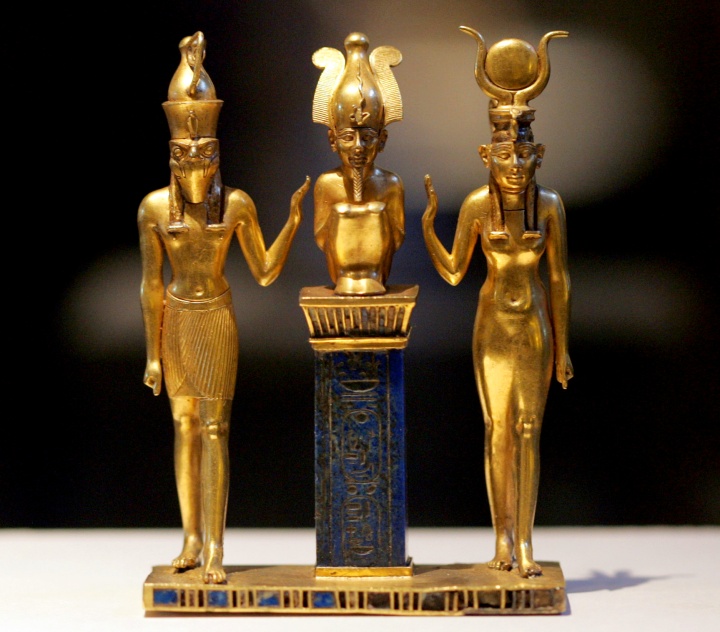You are correct.
But since trins are triune God believers, their god is a false god.
blessings.
- Corruption spread everywhere!
Many who believe in the Trinity are surprised, perhaps shocked, to learn that the idea of divine beings existing as trinities or triads long predated Christianity. Yet, as we will see, the evidence is abundantly documented.

www.ucg.org
- The triad of Sumeria!
-The triad of Babylonia!
- The triad of India!
- The trinity of Greece!
- The trinity of Egypt!
- The trinity of Phoenicia!
- The trinity of Rome!
- The Germanic trinity!
- The trinity of the celts!
- The trinity of Egypt!
How Ancient Trinitarian Gods Influenced Adoption of the Trinity
Many who believe in the Trinity are surprised, perhaps shocked, to learn that the idea of divine beings existing as trinities or triads long predated Christianity. Yet, as we will see, the evidence is abundantly documented.
Marie Sinclair, Countess of Caithness, in her 1876 book
Old Truths in a New Light, states: "It is generally, although erroneously, supposed that the doctrine of the Trinity is of Christian origin.
Nearly every nation of antiquity possessed a similar doctrine. [The early Catholic theologian] St. Jerome testifies unequivocally,
'All the ancient nations believed in the Trinity'" (p. 382).
Notice how the following quotes document belief in a divine trinity in many regions and religions of the ancient world.
Sumeria
"The universe was divided into three regions each of which became the domain of a god. Anu's share was the sky. The earth was given to Enlil. Ea became the ruler of the waters.
Together they constituted the triad of the Great Gods" (
The Larousse Encyclopedia of Mythology, 1994, pp. 54-55)
Babylonia
"The ancient Babylonians
recognised the doctrine of a trinity, or three persons in one god—as appears from a composite god with three heads forming part of their mythology, and the use of the equilateral triangle, also, as an emblem of such trinity in unity" (Thomas Dennis Rock,
The Mystical Woman and the Cities of the Nations, 1867, pp. 22-23).
India
"The Puranas, one of the Hindoo Bibles of more than 3,000 years ago, contain the following passage: 'O ye three Lords! know that I recognize only one God. Inform me, therefore, which of you is the true divinity, that I may address to him alone my adorations.' The three gods, Brahma, Vishnu, and Siva [or Shiva], becoming manifest to him, replied, 'Learn, O devotee, that there is no real distinction between us. What to you appears such is only the semblance.
The single being appears under three forms by the acts of creation, preservation, and destruction,
but he is one.'
"Hence the triangle was adopted by all the ancient nations as a symbol of the Deity . . . Three was considered among all the pagan nations as the chief of the mystical numbers, because, as Aristotle remarks, it contains within itself a beginning, a middle, and an end. Hence we find it designating some of the attributes of almost all the pagan gods" (Sinclair, pp. 382-383).
Greece
"In the Fourth Century B.C. Aristotle wrote: 'All things are three, and thrice is all: and let us use this number in the worship of the gods; for, as the Pythagoreans say, everything and all things are bounded by threes, for the end, the middle and the beginning have this number in everything, and these compose the number of the Trinity'" (Arthur Weigall,
Paganism in Our Christianity, 1928, pp. 197-198).
Egypt
"The
Hymn to Amun decreed that 'No god came into being before him (Amun)' and that
'All gods are three: Amun, Re and Ptah, and there is no second to them. Hidden is his name as Amon, he is Re in face, and his body is Ptah.' . . .
This is a statement of trinity, the three chief gods of Egypt subsumed into one of them, Amon. Clearly, the concept of organic unity within plurality got an extraordinary boost with this formulation.
Theologically, in a crude form it came strikingly close to the later Christian form of plural Trinitarian monotheism" (Simson Najovits,
Egypt, Trunk of the Tree, Vol. 2, 2004, pp. 83-84).
Other areas
Many other areas had their own divine trinities. In Greece they were Zeus, Poseidon and Adonis. The Phoenicians worshipped Ulomus, Ulosuros and Eliun. Rome worshipped Jupiter, Neptune and Pluto. In Germanic nations they were called Wodan, Thor and Fricco. Regarding the Celts, one source states, "The ancient heathen deities of the pagan Irish[,] Criosan, Biosena, and Seeva, or Sheeva, are doubtless the Creeshna [Krishna], Veeshnu [Vishnu], [or the all-inclusive] Brahma, and Seeva [Shiva], of the Hindoos" (Thomas Maurice,
The History of Hindostan, Vol. 2, 1798, p. 171).
"The origin of the conception is entirely pagan"
Egyptologist Arthur Weigall, while himself a Trinitarian, summed up the influence of ancient beliefs on the adoption of the Trinity doctrine by the Catholic Church in the following excerpt from his previously cited book:
"It must not be forgotten that Jesus Christ never mentioned such a phenomenon [the Trinity], and nowhere in the New Testament does the word 'Trinity' appear. The idea was only adopted by the Church three hundred years after the death of our Lord;
and the origin of the conception is entirely pagan . . .
"The ancient Egyptians, whose influence on early religious thought was profound, usually arranged their gods or goddesses in trinities: there was the trinity of Osiris, Isis, and Horus, the trinity of Amen, Mut, and Khonsu, the trinity of Khnum, Satis, and Anukis, and so forth . . .
"The early Christians, however,
did not at first think of applying the idea to their own faith. They paid their devotions to God the Father and to Jesus Christ, the Son of God, and they recognized the mysterious and undefined existence of the Holy Spirit;
but there was no thought of these three being an actual Trinity, co-equal and united in One . . .
"The application of this old pagan conception of a Trinity to Christian theology
was made possible by the recognition of the Holy Spirit as the required third 'Person,' co-equal with the other 'Persons' . . .
"The idea of the Spirit being co-equal with God
was not generally recognised until the second half of the Fourth Century A.D. . . . In the year 381 the Council of Constantinople added to the earlier Nicene Creed a description of the Holy Spirit as 'the Lord, and giver of life, who proceedeth from the Father, who with the Father and Son together is worshipped and glorified.' . . .
"Thus, the Athanasian creed, which is a later composition but reflects the general conceptions of Athanasius [the 4th-century Trinitarian whose view eventually became official doctrine] and his school, formulated the conception of a co-equal Trinity wherein the Holy Spirit was the third 'Person'; and
so it was made a dogma of the faith, and belief in the Three in One and One in Three became a paramount doctrine of Christianity, though not without terrible riots and bloodshed . . .
"Today a Christian thinker . . . has no wish to be precise about it, more especially since
the definition is obviously pagan in origin and was not adopted by the Church until nearly three hundred years after Christ" (pp. 197-203).
James Bonwick summarized the story well on page 396 of his 1878 work
Egyptian Belief and Modern Thought: "It is an undoubted fact that
more or less all over the world the deities are in triads. This rule applies to eastern and western hemispheres, to north and south.
"Further, it is observed that, in some mystical way, the triad of three persons is one. The first is as the second or third, the second as first or third, the third as first or second; in fact, they are each other, one and the same individual being.
The definition of Athanasius, who lived in Egypt,
applies to the trinities of all heathen religions."





